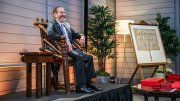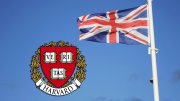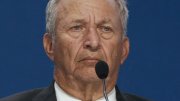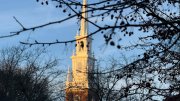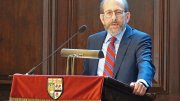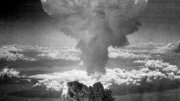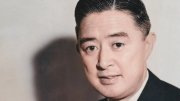Harvard presidential installation ceremonies typically take place in Tercentenary Theatre, attended by thousands. These are not typical times—but certain traditions must nevertheless be observed. In that spirit, a small, private celebration, which included elements of Harvard’s traditional installation ceremony, took place in Menschel Hall at the Harvard Art Museums on the evening of Saturday, December 7, to mark Alan M. Garber’s appointment as Harvard’s thirty-first president. Garber, who served as provost from September 2011 until he was named interim president on January 2, 2024—following the resignation of Claudine Gay—was named president by the Harvard Corporation in August. He will serve in that role through the end of the 2026-2027 academic year. The event was attended by friends, family, members of the governing boards, deans and other University leaders, as well as four of Harvard’s six living former presidents—Lawrence Bacow, Drew Faust, Claudine Gay, and Lawrence Summers.
Former senior fellow of the Harvard Corporation William F. Lee ’72, current senior fellow Penny Pritzker ’81, and Faust all spoke, Rabbi William G. Hamilton of the Congregation Kehillath Israel in Brookline gave the benediction, and Carolyn Hao ’26 sang “Fair Harvard.”
Said Faust, “Alan is interested in everything, curious about everything… he is an intellectual and a practitioner, a thinker and a doer. At a time when trust in institutions generally, and in higher education in particular, has eroded so markedly, Alan radiates trustworthiness.”
Lee praised Garber as a leader of “unflappability and humility” who has demonstrated a “fundamental and unwavering determination to advance the best interests of the institution and the broader Harvard community.”
Their remarks were followed by the charge and presentation of the insignia of office, led by Vivian Hunt ’89, M.B.A. ’95, president of the Board of Overseers, together with the past presidents in attendance. Summers presented Garber with the first of these symbols of authority: the Corporation Seal of 1650, and the Great Seal of the University, adopted in 1885. Bacow handed him two silver keys, meant to open doors to truth and knowledge, while Gay presented the oldest volume of College records, dating to 1639. Faust, who hired Garber as provost in 2011, presented the Charter of 1650, granted by the Great and General Court of the Colony of Massachusetts Bay (this being the document which establishes Harvard as the oldest corporation in the Western Hemisphere).
Installation addresses are often occasions for a newly appointed president to outline an agenda for the decade ahead. Given Garber’s planned short tenure as president, his speech was instead—like the event itself—calibrated to be modest: mindful of the legacy entrusted to him, thankful to those who supported him, and awake to the exigencies of long-term planning at an institution that has much to contribute to the world.
He began by referring with circumspect humor to the notorious discomfort of the famous Holyoke Chair, the turned sixteenth-century seat from which the president presides during Commencement: [I]t’s not as uncomfortable as I expected it to be,” he said, “but it was surprisingly warm when I sat on it during Commencement. It seems to be growing hotter by the day.”
Garber’s full speech follows:
Thank you. Good evening.
Nothing fortifies quite like a room full of colleagues and dear friends, including my partners in the work and my predecessors in the Holyoke Chair. As to the chair, it’s not as uncomfortable as I expected it to be, but it was surprisingly warm when I sat on it during Commencement. It seems to be growing hotter by the day.
Seating aside, I am moved beyond measure by your presence here this evening. This is, in some ways, an inverted lecture. Each of you has taught me important lessons that have guided me to this point: what it means to be part of the higher education community and to be part of this university; what it means to be an academic, an economist, a physician, a leader, a human being; what it means to meet the present guided by purpose and to imagine a future lit by possibility.
But only four of you have taught me what it means to be a father—and only one of you has taught me what it means to be a husband.
Dan, Ben, Ali, Andrew, I’ll never forget what the head of school at Gideon Hausner said to your mother, many years ago. He told her that we were blessed in our children. Your mother and I knew it was true then, and I’m reminded of it every day.
And, Anne, you have brought out the best in our family and the best in me. Neither would have been possible if you were not the best person I know. You and our children have made my life worth living. I can never express my gratitude adequately, so for now, let me simply say thank you.
I returned to Harvard in 2011 to serve as provost. Thank you, Drew, for seeing something in me that I didn’t know was there, and for being both persistent and persuasive. Thank you, Bill, for that first meeting in Mass Hall, and for everything that followed. I’ll admit that, at the time, I had my doubts about the transition from professor to academic leader. Could service to my alma mater–with all of the mediation and meetings that such service demands—be as challenging, as varied, and as stimulating as my previous existence as a researcher and teacher?
Now, more than 13 years later, I can say the answer is a resounding yes, though there are parts of me that still miss the special place that I left for Harvard. Many years ago, when I told Henry Rosovsky about my plans to move from Boston to Stanford to begin my first faculty position, his reaction was classic Henry. He had been the long-serving dean of FAS and embodied our University as much as anyone. Henry couldn’t imagine returning to the Golden State, where he had studied years before, because it was, as he put it, “too much like Shangri La.” For him, that was a bug, not a feature.
Of the many ways I’ve heard people describe Harvard over the years, I don’t recall anyone comparing it to that mythical bit of heaven. Though there is an important similarity: Our tenured faculty, like the inhabitants of Shangri La, lead exceptionally long lives. And they very seldom leave.
Perhaps Shangri La and Harvard have another similarity: timelessness. At Harvard, we are always conscious of our long history. That history—approaching 400 years, making us one of the oldest institutions of any kind in North America, and, for the last century, one of the most influential in the world—shapes the way we think and act now, as well as the possibilities that we imagine for our future.
Our University is rich in beloved traditions—and richer still in accomplishments. Morning Prayers started in 1636, and Commencement, a personal favorite, commenced in 1642. From those days to these, the people of Harvard have made contributions to humanity that defy accounting. Even reciting a partial litany of worthies would take me through the weekend.
But allow me to share some recent favorites. When the Radcliffe Institute celebrated its 25thanniversary in late September, I found myself moderating a lively and illuminating conversation between Claudia Goldin and Oliver Hart, Nobel prize-winning economics professors. Ten days later, I found myself congratulating the Medical School’s Gary Ruvkun, who had just received word of his own Nobel Prize in medicine. Between these two events, I served as a delegate at the inauguration of Melissa Gilliam, Harvard alum and now president of Boston University; I attended a barbecue with Harvard veterans and ROTC cadets; and I traveled to New York to see another medical school faculty member, Cigall Kadoch, receive the Blavatnik National Award for Young Scientists in life sciences. Her research may one day change how we treat and cure cancer, among other maladies. The work done at Harvard—the good it does in the world—the good it will do in the world—is wonderfully abundant.
This is not to say that our University is unassailably good, of course. Members of the Harvard community have, throughout history, marginalized and excluded or ignored entire groups of individuals, and embraced and encouraged practices that we now condemn. Our predecessors did wrong alongside right, and those of us who have been fortunate enough to inherit this institution—including those of us who would surely have been turned away from it in the past—still contend with a complicated legacy.
How does that legacy influence our present—and our future?
Accomplishment, longevity, and resources have led to prominence and visibility. People inside and outside of academia pay attention to what Harvard does—and what Harvard fails to do. People share their opinions and suggestions readily. Most of them care about our University. While our institutional self-importance may, on occasion, be overblown, our institutional self-consciousness and self-reflection are justified and necessary if we are to avoid complacency. That, too, is an important part of our legacy—one that we carry to a person.
Harvard has been a part of me since I arrived on campus in the fall of 1973, and I have been part of Harvard for 51 of its 388 years. When I last sat in this chair in May—at Commencement—I was presiding over what we call our festival rites. At several points, I was acutely aware of two facts: One, that I was almost continuously visible to those watching in Tercentenary Theatre or elsewhere, for all time, thanks to streaming and recording. No frowning, zoning out, or dozing allowed. And, two, that the chair was perched on the edge of a raised platform. At my favorite event of the year, after having been part of Harvard for nearly three-quarters of my life, I found myself worried about falling flat on my face. I tried not to move a muscle. Prominence and visibility—and the close scrutiny they invite—can be paralyzing for individuals and for institutions alike.
Our long history—with the reputation we’ve acquired—is a priceless gift. Awareness of how damaging the loss of that reputation could be is among the reasons why we often proceed with caution, when we proceed at all. With so much at stake, it is prudent to do so. Yet we forfeit opportunities when we feel as though the University cannot make a move without considering every possible ramification, without fully understanding every possible consequence. In a world that confronts us with challenges and opportunities more frequently than ever before, we will need to move forward with greater alacrity—and to correct course more quickly—than has been our custom.
An excessive aversion to risk is a risk in and of itself. We must keep in mind, always, that the mistakes we have made—individually and collectively—may have been plentiful, but we have our long history to celebrate because they have not been fatal. Assuming that this trend continues, our history demands that we plan—boldly—for a very long future. We need to think not only in years and decades, but also in centuries.
So here we are, not in Shangri La, but in a place that is neither placid nor hidden. What we do here matters. A sketch of the shield bearing the word Veritas appears in the first of the College Books, inscribed on a coat of arms nearly 381 years ago and passed over the generations to all of us. That one word conveys both our purpose and the source of our strength as we fulfill our mission of excellence in the pursuit and dissemination of knowledge. Despite the challenges we face, we will discover; we will learn; we will make the world a better place. As president, I intend to work with you to ensure that we do so as faithfully, as energetically, and as successfully as possible, so that we and those who follow us can make this institution as vital to our nation and our world as it has ever been. With our efforts, may Fair Harvard, ever guided by Veritas, grow fairer still.
Thank you.
Read the Gazette coverage of the event here.
